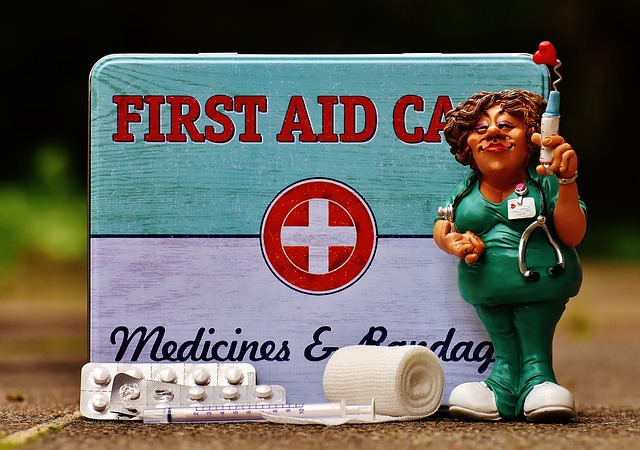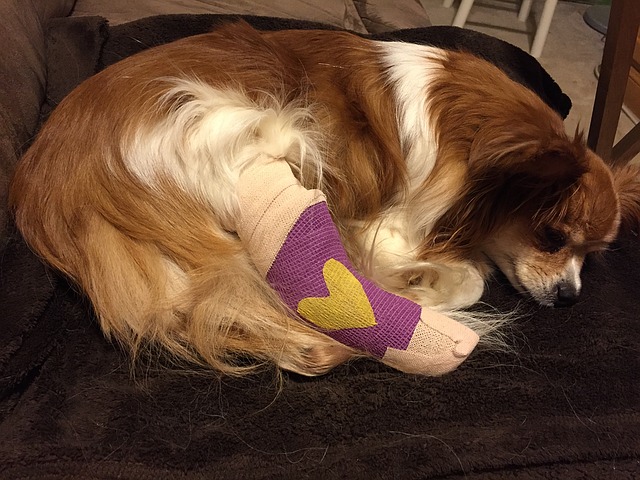Accidents, illnesses, and injuries can happen at any time. Are you prepared to care for your dog in an emergency situation? You may know the basics of first aid like bandaging a cut, but do you know what to do if your dog is choking? What if they break a leg? Or stop breathing? Will you be prepared to face one of these severe emergencies? Stopping to Google could mean the difference between life and death for your fur child. You should familiarize yourself with these tips now, before an emergency occurs, and consider printing some of the key information – such as how to perform CPR – and keeping it in an easily-accessible place, like on the fridge. Here are 10 first aid tips that every dog owner needs to know.

#1 – Have a pet first aid kit handy
Sure, some of these items may be available in your regular first aid kit, but when seconds matter, it helps to have everything handy for a dog emergency all in one place. Here are some supplies recommended by the Humane Society of the United States that you should keep in your pet first aid kit.
-Pet first aid book (or information printed from the internet)
–Phone numbers, addresses, and maps or directions (if necessary) for your dog’s regular vet, the nearest emergency vet, and a poison control center or hotline (the ASPCA poison-control center can be reached at 1-800-426-4435)
-Your dog’s current vaccination, medical, and microchip information, along with a recent photo in case your dog gets lost
-A regular, non-retractable, leash
–Vet tape wrap; absorbent gauze pads; adhesive tape; cotton balls; gauze rolls; sterile, non-stick gauze pads; splints; tongue depressors
-Disposable gloves; ice pack; tweezers; emergency blanket; rectal thermometer (your pet’s temperature should not rise above 103°F or fall below 100°F); scissors with blunt ends; sample credit card (from direct-mail credit-card offers) to scrape away insect stingers; flashlight; eye dropper or syringe; towels; needle-nose pliers

-Antiseptic wipes or spray; hydrogen peroxide (used to induce vomiting only when recommended by a vet or poison control expert); petroleum jelly (to lubricate the thermometer); sterile saline solution; ear cleaner; antibiotic ointment; rubbing alcohol to clean the thermometer; styptic powder to stop bleeding (especially from nails trimmed too short)
-Diphenhydramine (Benadryl®), if approved by a veterinarian for allergic reactions. A veterinarian must tell you the correct dosage for your pet’s size.
-A muzzle or strips of cloth to tie your dog’s mouth shut. Animals in pain often react by biting anything that comes near them, including their favorite person. According to VCA Hospitals:
“The stress of an emergency involving a pet or owner can cause an otherwise friendly animal to act aggressively. Although most panicky dogs will respond to a calm, soothing voice and gentle stroking of the head and shoulders, use caution when approaching or touching any injured animal. It is important to ensure the safety of all rescue personnel that are attempting to assist with an injured animal.”
DO NOT muzzle a dog that is choking, vomiting, coughing, or having trouble breathing.
-A pet carrier or a large board to use as a stretcher

Know what to do if…
#2 – Your dog is choking
If your dog starts having trouble breathing, is pawing at their mouth, is making coughing or choking sounds, and especially if their tongue or gums are blue-tinged, your dog is choking and needs immediate help. BE CAREFUL: a choking pet is likely to bite in its panic. If your dog is still breathing, keep them calm and rush them to a vet. You may first check to see if you can safely remove the object, but make sure to avoid pushing it farther into the throat. According to the American Veterinary Medical Association (AVMA):
“If you can’t remove the object or your pet collapses, place both hands on the side of your pet’s rib cage and apply firm quick pressure, or lay your pet on its side and strike the rib cage firmly with the palm of your hand 3-4 times. The idea behind this is to sharply push air out of their lungs and push the object out from behind. Keep repeating this until the object is dislodged or until you arrive at the veterinarian’s office.”
#3 – Your dog is not breathing
The key here is to stay calm – you can’t help your dog if you are panicked. The AVMA recommends:
“Open your pet’s airway by gently grasping its tongue and pulling it forward (out of the mouth) until it is flat. Check the animal’s throat to see if there are any foreign objects blocking the airway. Perform rescue breathing by closing your pet’s mouth (hold it closed with your hand) and breathing with your mouth directly into its nose until you see the animal’s chest expand. Once the chest expands, continue the rescue breathing once every 4 or 5 seconds.”
Hopefully you will have somebody who can take you and your dog to the vet while this is in progress.
#4 – Your dog has no heartbeat
First, check to make sure your dog doesn’t have anything blocking his airway and begin doing rescue breathing. Lay him on his RIGHT side – his heart is in the lower half of his chest on the left side of his body, just behind the front left leg. Place one hand underneath your dog and the other hand over his heart. Press down gently on the heart – about one inch down for medium-sized dogs – 80-120 times per minute. Alternate chest compressions with rescue breaths every 4-5 seconds. Continue until your dog’s heart restarts or you arrive at a vet clinic.
#5 – Your dog has a heat stroke
Some symptoms of heat stroke include: panting, excessive drooling, fast or irregular heart rate, vomiting blood, muscle tremors, and seizures. If you believe your dog has suffered a heat stroke, you need to get them out of the heat immediately, preferably straight to the vet. Place a cool, wet towel around his head and neck (avoiding the eyes, nose, and mouth); wring it out, rewet it, and rewrap it every few minutes. Meanwhile, pour or hose cool water on your dog’s body and between his back legs, using your hand to sweep away water that has already absorbed your dog’s heat. Get your dog to a vet as soon as possible for further treatment.
#6 – Your dog has a seizure
Keep your dog away from objects that may injure him (such as furniture), but do not attempt to restrain him. A typical seizure lasts 2-3 minutes – time the length of the seizure, keep your dog warm and quiet, and immediately contact your vet for further instructions.
#7 – Your dog is bleeding
Muzzle your dog – they tend to react to pain by biting. The AVMA recommends:
“Press a clean, thick gauze pad over the wound, and keep pressure over the wound with your hand until the blood starts clotting. This will often take several minutes for the clot to be strong enough to stop the bleeding. Instead of checking it every few seconds to see if it has clotted, hold pressure on it for a minimum of 3 minutes and then check it. If bleeding is severe and on the legs, apply a tourniquet (using an elastic band or gauze) between the wound and the body, and apply a bandage and pressure over the wound. Loosen the tourniquet for 20 seconds every 15-20 minutes. Severe bleeding can quickly be life-threatening—get your animal to a veterinarian immediately if this occurs.”

#8 – Your dog has a fracture
Muzzle your dog, then use either a stretcher made from a firm surface, like a board, or a sling made from a blanket or towel to transport your dog to the vet. You may attempt to splint the wound, but a bad splint is worse than none at all, so it’s usually best to wait until you reach the vet.
#9 – Your dog has a burn
Muzzle your dog. Chemical burns should be flushed with copious amounts of water. Apply an ice cold compress to other burns.

#10 – Your dog consumed something toxic or poisonous
If your dog has gotten into a household chemical, follow the label directions for accidental contact, which may include flushing eyes with water or washing skin with soap and water, then call your vet. According to the AVMA:
“If you know your pet has consumed something that may be harmful, or if the animal is having seizures, losing consciousness, is unconscious or is having difficulty breathing, telephone your veterinarian, emergency veterinary clinic or the Animal Poison Control Center hotline (888.426.4435 – available 365 days/year, 24 hours/day) immediately. There is a fee for the consultation. If possible, have the following information available:
Species, breed, age, sex, weight and number of animals involved
Symptoms
Name/description of the substance that is in question; the amount the animal was exposed to; and the length of time of the exposure (how long it’s been since your pet ate it or was exposed to it).
Have the product container/packaging available for reference.
Collect any material your pet may have vomited or chewed, and place it in a plastic sealable bag to take with you when you bring your animal in for veterinary treatment.”
Any emergency involving your fur child can be terrifying, but with a little bit of preparation, you can save precious time that can mean the difference between life and death.
(H/T: AVMA, HSUS, VCA Hospitals, PetMD)
